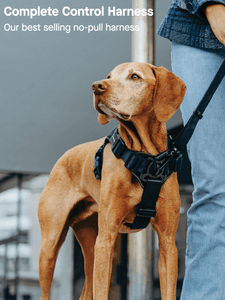Return to Blog
dog walking
How do you use a Front Clip Dog Harness
By Jackie Serpe on Aug 30, 2024
Front clip dog harnesses have become increasingly popular among pet parents for their ability to provide better control over dogs, particularly those that tend to pull on their leash. This comprehensive guide will discuss what a front clip dog harness is, the different types available, and how they compare to back clip harnesses. Additionally, we'll cover how to measure your dog for a perfect fit, the proper way to use these harnesses, and the advantages and disadvantages of pull dog harnesses.
What Is a Front Clip Dog Harness?
A front clip dog harness is a specialized type of dog harness designed to provide better control and discourage pulling behavior in dogs. Unlike traditional harnesses, the front clip harness features a leash attachment point on the chest area, rather than on the back. This design allows for more effective guidance and redirection of your furry friend during walks. Front clip harnesses are popular among dog parents seeking a humane and efficient way to manage their pets' walking habits.
What Are the Different Types of Dog Harnesses?
Dog harnesses come in various styles, each serving different purposes and catering to specific needs. The most common types include:
- Back clip harnesses: These feature a leash attachment on the dog's back and are suitable for well-behaved dogs.
- Front clip harnesses: Designed to discourage pulling, these harnesses have a leash attachment on the chest.
- Dual clip harnesses: Offering both front and back attachment points, these harnesses provide versatility for different situations.
- No-pull harnesses: Similar to front clip harnesses, these are specifically designed to prevent pulling behavior.
- Step-in harnesses: Easy to put on, these harnesses require the dog to step into them before securing.
Understanding the different types of dog harnesses can help pet parents choose the most suitable option for their furry companions.
How Do Front Clip Dog Harnesses Differ from Back Clip Harnesses?
Front clip dog harnesses and back clip harnesses differ primarily in their leash attachment points and intended purposes. Front clip harnesses feature a leash attachment on the dog's chest, which provides better control and discourages pulling. When a dog pulls, the front clip design causes them to turn towards the owner, redirecting their attention. Back clip harnesses, on the other hand, have the leash attachment on the dog's back, which can actually encourage pulling behavior in some dogs. While back clip harnesses are suitable for well-behaved dogs or smaller breeds, front clip harnesses are often preferred for training purposes and managing strong pullers.
What Are the Benefits of Choosing a Front Clip Dog Harness?
Choosing a front clip dog harness offers several benefits for both dogs and their parents. Firstly, these harnesses provide better control during walks, making it easier to manage strong or excitable dogs. The front attachment point discourages pulling by redirecting the dog's momentum, which can lead to more enjoyable and safer walks. Additionally, front clip harnesses distribute pressure more evenly across the chest, reducing strain on the neck and throat that can occur with traditional collars. This design is particularly beneficial for breeds prone to respiratory issues or those with delicate necks. Front clip harnesses also serve as effective training tools, helping to teach proper leash manners and promote positive walking habits.
How Do You Properly Measure Your Dog for a Front Clip Harness?
Properly measuring your dog for a front clip harness is crucial to ensure a comfortable and secure fit. To get accurate measurements, start by measuring your dog's chest girth, which is the widest part of their chest, typically just behind the front legs. Use a flexible tape measure and wrap it snugly around your dog's body, making sure it's not too tight or loose. Next, measure the neck circumference by placing the tape measure where a collar would normally sit. Some front clip harnesses may also require a measurement of your dog's length from the base of the neck to the base of the tail. Always consult our sizing guide, as measurements can vary between products. For more on how to fit a front clip harness, check out our guide!
Why is Correct Sizing Crucial for a Front Clip Harness?
Correct sizing is crucial for a front clip harness to ensure both comfort and effectiveness. A properly fitted harness allows for a full range of motion without chafing or restricting movement. If the harness is too loose, it may not provide adequate control and could potentially allow your dog to slip out during walks. Conversely, a harness that's too tight can cause discomfort, or skin irritation. The correct size also ensures that the front clip is positioned properly on the chest, maximizing its effectiveness in discouraging pulling behavior. Taking accurate measurements and following our sizing guidelines is essential for selecting the right front clip harness for your dog.
How Do You Use a Front Clip Dog Harness?
Using a front clip dog harness is a straightforward process that can greatly improve your dog's walking experience. Front clip harnesses are designed to discourage pulling by redirecting your dog's attention back to you when they try to lunge forward. To use one effectively, start by ensuring you have the correct size for your dog.
What Are the Useful Tips for Dog Owners Using a Front Clip Harness?
There are several useful tips for dog owners to maximize the benefits of a front clip harness. First, always check the fit before each walk to ensure the harness hasn't loosened or shifted. Second, keep the leash slack when walking to prevent constant tension on the harness. Third, use verbal cues and treats to reinforce good walking behavior. Lastly, be patient and consistent in your training approach, as it may take time for your dog to fully adjust to the new walking style.
For more information on front clip harnesses check out our complete guide to front clip harnesses.


